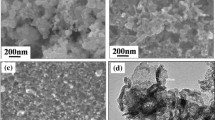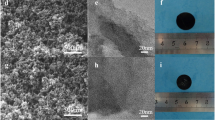Abstract
Mesoporous polyethylene glycol-resorcinol and formaldhyde (PEG-RF) carbon xerogels were prepared by a new polymer blend method in which PEG-RF mixed organic xerogels were synthesized by blending thermally unstable polyethylene glycol with organic monomers, resorcinol and formaldhyde and then subjected to pyrolization at 1 000 °C. The influences of mass ratio PEG to the theoretical yield of RF xerogel, m(PEG)/m(RF) and the relative molecular mass of PEG on the pore structure and electric double layer capacitance (EDLC) performance of PEG-RF carbon xerogels were investigated. The results show that PEG under different conditions leads to the difference of phase separation structure of the polymer blend and thus the change of pore structure of PEG-RF carbon xerogels. Specific surface area and capacity of PEG-RF carbon xerogels in 30% H2SO4 solution can reach 755 m2/g and 150 F/g, respectively. Their surface can be fully utilized to form electric double layer. However, the pore structure differences of PEG-RF carbon xerogels result in their different EDLC performances. The distributed capacitance effect increases with decreasing the pore size of PEG-RF carbon xerogels.
Similar content being viewed by others
References
Conway B E. Transition from “supercapacitor” to “battery” behavior in electrochemical energy storage [J]. J Electrochem Soc, 1991, 138(6): 1 539–1 548.
Sarangapani S, Tilak B V, Chen C P. Materials for electrochemical capacitors: theoretical and experimental constraints [J]. J Electrochem Soc, 1996, 143 (11): 3 791–3 799.
Burke A. Ultracapacitors: why, how, and where is the technology [J]. J Power Sources, 2000, 91: 37–50.
Kötz R, Carlen M. Principles and applications of electrochemical capacitors [J]. Electrochimica Acta, 2000, 45(15–16): 2 483–2 498.
Bonnefoi L, Simon P, Fauvarque J F, et al. Electrode optimization for carbon power supercapacitors [J]. J Power Sources, 1999, 79: 37–42.
Shi H. Active carbons and double layer capacitance [J]. Electrochimica Acta, 1996, 41 (10): 1 633–1 639.
Qu D Y, Shi H. Studies of activated carbons used in double-layer capacitors [J]. J Power Sources, 1998, 74: 99–107.
Gamby J, Taberna P L, Simon P, et al. Studies and characterizations of various activated carbons used for carbon/carbon supercapacitors [J]. J Power Sources, 2001, 101: 109–116.
Kyotani T. Control of pore structure in carbon [J]. Carbon, 2000, 38(2):269–286.
Ozaki J, Endo N, Ohizumi W, et al. Novel preparation method for the production of mesoporous carbon fiber from a polymer blend [J]. Carbon, 1997, 35(7): 1 031–1 033.
Hatori H, Kobayashi T, Hanzawa Y, et al. Mesoporous carbon membranes form polyimide blended with poly ethylene glycol[J]. J Appl Poly Sci, 2001, 79(4): 836–841.
HOU Zhao-hui, LI Xin-hai, HE Ze-qiang, et al. Preparation and electrochemical capacitance of carbon xerogel from a new polymer blend method [J]. J Cent South Univ, 2004, 35(4): 581–586. (in Chinese)
Pekala R W. Organic aerogels from the polycondensation of resorcinol with formaldehyde [J]. Journal of Material Science, 1989, 24(9): 3 221–3 227.
Sing K S W, Everett D H, Haul R A W, et al. Reporting physisorption data for gas/solid systems—with special reference to the determination of surface area and porosity [J]. Pure & Appl Chem, 1985, 57(4): 603–619.
de Levie R. On porous electrodes in electrolyte solutions [J]. Electrochimica Acta, 1963, 8(5): 751–780.
Austin L G, Gagnon E G. The triangular voltage sweep method for determining double-layer capacity of porous electrodes [J]. J Electrochem Soc, 1973, 120(2): 251–254.
Endo M, Kim Y J, Takeda T, et al. Poly vinylidene chloride-base carbon as an electrode material for high power capacitors with an aqueous electrolyte [J]. J Electrochem Soc, 2001, 148(10): 1 135–1 140.
Author information
Authors and Affiliations
Corresponding author
Rights and permissions
About this article
Cite this article
Hou, Zh., Li, Xh., He, Zq. et al. Influence of polyethylene glycol on pore structure and electric double-layer capacitance of carbon xerogel. J Cent. South Univ. Technol. 11, 255–260 (2004). https://doi.org/10.1007/s11771-004-0052-z
Received:
Accepted:
Issue Date:
DOI: https://doi.org/10.1007/s11771-004-0052-z




